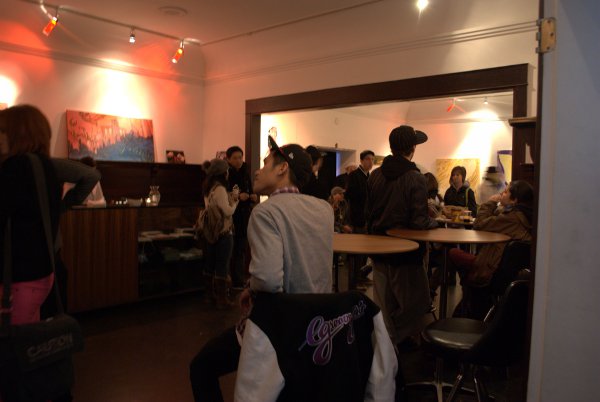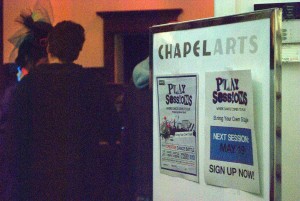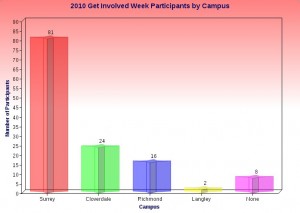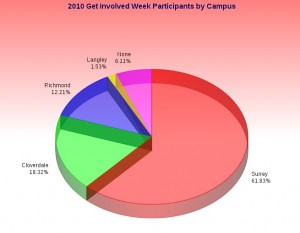How Theatre Terrific brings equality to the stage
March 10, 2011 by Sarah Casimong · Leave a Comment
Theatre Terrific does what most theatres are scared to do: Put new actors and people with disabilities and mental health issues on the same stage as professional actors who don’t have those challenges.
It started in 1985 when a group of parents started theatre classes for their adult children with developmental challenges. They hired a professional instructor, with the aim of giving their kids a creative outlet.
The theatre is now open to anyone with or without a “challenge.” According to Susan Uchatius, artistic director, it is important for them to treat everybody equally.
“You’ll have professional actors, you’ll have maybe someone in a wheelchair, you’ll have someone with Down syndrome, you’ll have some people that have mental health issues,” said Uchatius. “[Just] because you might have a labelled challenge or disability, you’re not special in this circle. You’re going to be equal to the person beside you, who may be a professional equity actor.”
As challenging as that may sound, Uchatius insists that the process to putting all actors on even ground is simple. It starts with what they call stonework: All the actors quietly stand in a circle, breathe, make eye contact with the person beside them and pass around a stone.
“It’s all about finding out what our human connections are,” said Uchatius. “It’s so amazing how, by this ritual, you find that you are more similar than you are different. We all have the same hopes and desires and dreams, it’s just in a different package.”
Uchatius hopes that the theatre community and society in general will look at Theatre Terrific as not disability or charity work, but as a form of valid artistic expression.
“When I see a theatre that has disability or is mixed [actors with and without disabilities], I see a lot that’s done from a charitable aspect and it offends me, to be honest,” said Uchatius. “When I see that people are being indulged, you’ll have one or two people that are different and the expectation isn’t there for them to do anymore.
“What Theatre Terrific does is we give the respect of challenge. If you’re going to come in the door to work, like any other artist, be expected to fall, be expected to make a lot of mistakes, be expected to work hard, be expected to push your boundaries. That’s respect.”
Even though actors of different backgrounds and challenges are treated and seen as equal, Uchatius still appreciates the variety of people and the diversity it brings to the stage.
“I’d rather work at this theatre than any other kind because it’s so mosaic, it’s so multicoloured,” said Uchatius. “It’s like an incredible rainbow because you’re going to have perceptions that are so unique.”
Chapel Arts, an unorthodox use of a chapel
February 28, 2011 by Sarah Casimong · Leave a Comment
Despite being a chapel, Chapel Arts has nothing to do with worship unless the subject of praise is the art displayed throughout the building.
When Chapel Arts first opened as a venue three years ago, the words on the window read: “If nothing else believe in art.”
“I’m just not religious,” said Nathan Wiens, owner of Chapel Arts. “I was raised in a family filled with artists and stuff, so I guess that’s what I believe in. I believe in makers instead of The Maker.”
What was once known as the Armstrong Funeral Chapel was owned by the Armstrong family for 103 years, according to Wiens. He bought the chapel in 2005, in what he calls “an accident.”
While searching for a space to make art and furniture, Wiens found a building across the street from the chapel. He was forced to buy the chapel in order to get the shop, as the two buildings had to be bought together. His intial intention was to sell the chapel, but he soon fell in love with its charm and set out to get a licence from the city to open it as a venue.
“That was a very long, educational process,” said Wiens. “[It] took about 22 months to get a licence from the city of Vancouver. They’re very strange. Bureacracy is a very strange thing.”
He claims it was the biggest challenge he faced.
“It cost as much money to wait for them as it cost to buy the real estate. It’s a long time to hustle for a simple business licence that isn’t a change of use but they decide to make it one. So it’s sort of disappointing.”
Once he got the chapel, Wiens renovated it as if it was still 1936, when the chapel’s was expanded, in order to keep its historical feel.
Since getting the licence, the chapel’s been successfully hosting events that include performance art, theatre, concerts, government meetings, conferences, workshops and movie work.
He compares the chapel to “a house party” when it hosts events. The chapel makes most of its money hosting family and corporate parties.
“I believe that everyone’s living in very small places so having an intimate venue like this, that has a homey feel, is kind of attractive to people.”
Although the unorthodox use of space and cozy feel attracts people, being located in the Downtown Eastside turns some people away but Wiens says that’s not always a bad thing.
“The neighbourhood’s a bit tough, but I like the neighbourhood, I don’t have a problem with it. It keeps a lot of people that wouldn’t really appreciate the place away. So it’s a self-screening process. But it keeps a lot of money way, so it’s a bit of both, there are pros and cons.”
Despite the cons, he manages to appreciate the history that comes with the chapel and the neighbourhood it’s a part of.
“It’s a bit tough in just this zone but I don’t think that will change,” said Wiens. “I think the ratios of the demographics will change. There will be less low-income housing in this neighbourhood in the future. It’s the oldest part of the city. It’s the beginning of Vancouver right here. This is where Vancouver started, right here.”
He has high hopes for the chapel and what it will continue to contribute to the Vancouver’s art community.
“I think it will just increase in success with the community,” said Wiens. “I think it’s gonna, whether it’s me running it or not, it’s gonna be around a long time as a public venue that will probably have a good arts base to it. I hope to hang onto it but one never knows.”
Visit chapelarts.com more information.
Desturbia: Hoping to become established through a web series
January 31, 2011 by Sarah Casimong · Leave a Comment

Allen Kumar, independent director and screenwriter, is currently shooting his web series Desturbia, set to go online in December. (Photo by Sarah Casimong)
Aspiring filmmakers don’t need a TV network or theatrical distributor anymore: they have the web.
That’s what Allen Kumar, a rookie director and screenwriter, is using for his first project, Desturbia. Desturbia is an independent murder mystery web series, currently shooting in different parts of Metro Vancouver.
“First what I was going to do was take it to a network. I wanted to establish myself and wanted to work as a PA [production assistant] or something, get in there [for] a few years, then pitch it to a network,” said Kumar.
He changed his mind after deciding that he wanted the freedom to make decisions on his own.
“In a web series, I can do it [all] myself,” said Kumar. “I won’t have a big budget but I can show that I can do it. And if I have a show that has people involved and people who are watching it, I can take it to a network and get a web series picked up, which I want to do after two seasons.
“If you look at it now, shows on network TV, they rely on a lot of ratings,” said Kumar. “Because you have a lower budget and you have more control of it, your web series can’t get canceled. Especially not at the beginning. So if you use a web series to get an audience, it shows the network that the show draws in people.”
Three years ago, Kumar started writing a screenplay out of boredom, basing the story on a crime that happened in his life. What started out as a 10-minute short became 30 minutes. Kumar considered making a film, but that idea didn’t last long.
“You can’t tell this story in a movie,” said Kumar. “You have to show the elements and have conflict and all the things building up to make this actually look real. Because if you make this into a movie, it will become some cheesy horror film, which I’m not trying to do. I’m trying to show [the story] and why these people did this.”
Kumar decided that a web series would be a perfect way to tell the story and develop the characters over a longer period of time.
“The internet is the best way right now. Not many people watch TV as much because everything is online with Youtube and MegaVideo. Studios are actually making web series now.” said Kumar.
An example, he said, is the TV series Ghost Whisperer which was canceled and then turned into a web series.
Although he is funding Desturbia on his own, he says sites such as IndieGoGo are a way to get funding. Other ways are through fundraising events or reaching out to businesses.
“It [can be] a lower budget, so you won’t be spending too much. Some web series, you don’t even need a major studio. You can shoot it in your bedroom.”
Although Kumar had to drop an expensive car chase scene from the pilot episode, because of the budget, he is still happy to see his vision played out.
“The best part would be the fact that when I write [the script] I don’t know if it’s really good but when I actually see it, when the actors play it out, I’m like ‘I must be good,’” said Kumar. “I know [the actors] add their own personalities and stuff, but the fact that it’s basically what the scene is actually about and it actually works and you [can] see it, it seems real, like you’re watching something on television.”
Desturbia is set to premiere in December or January 2012. For more information, visit Cyrus Entertainment’s website.
Mint Records: Surviving as an independent record label
January 23, 2011 by Sarah Casimong · Leave a Comment
The main goal is survival.
Mint Records is entering its 20th year and co-founder Bill Baker admits that changes in the music industry are a threat to independent music labels.
“As flippant as that sounds, [survival] is the number one goal and it always has been,” said Baker. “It’s a challenge and right now it’s just about this adaptation and seeing what we can do. A lot of people in the business have changed entirely. Record labels basically don’t put out records anymore, rather they do artist management and merchandising and publishing and things like that. [They're] focusing on other [ways] of working with bands and still have the potential to generate income.”
Changes in the music industry have forced Mint Records, like other labels, to revamp the traditional way of putting out music. One of the label’s suppliers, which has manufactured its CDs since 1994, is taking its last breath this year.
“We focus a lot more on putting out vinyl now,” said Baker. “We’ve been forced to cut back on the kind of investments we can make on projects. [In the past], we would’ve probably put out a record knowing that it was barely gonna break even, if that. But it was something that we felt passionate about doing. Now we may either not do that, or we may release it digitally only through iTunes, so we’re not actually incurring any manufacturing costs. It’s changed the way that we do things, for sure.”
In the beginning
Mint Records came to life in 1991 when Baker and his co-founder Randy Iwata came up with the idea of starting a record label after they left CiTR, UBC’s student-run radio station.
The early ’90s saw the growth of the grunge scene in Seattle, which had a huge influence on Vancouver’s music scene. Baker describes it as a vibrant time.
“There were a lot of new venues and up-and-coming new bands and people starting out. The whole punk thing had, at that time, gone by the wayside. We were getting new kinds of music and people were starting to explore. We certainly had no lack of material when it came time to find a band to work with,” said Baker.
At that time, Canada’s music industry was mostly based in Toronto, with branches of a few major labels in Vancouver. But despite being present, according to Baker, they failed to engage the local music scene.
“We recognized a bit of a niche, I suppose,” said Baker. “We weren’t the only people to do that at the time either.”
Baker and Iwata noticed the success of local independent label Nettwerk, but still saw a number of unsigned bands with potential.
“Here we got all these bands playing, people coming to see them and nobody’s really putting out their records. To be on Nettwerk, you had to be, at that point, reasonably well established. There’s a huge gap here with all these bands that we like, where are they gonna go? The majors won’t put them out and they’re not likely to be on Nettwerk,” Baker said.
“The goal was to just document what was going on in the music community in Vancouver at the time. There weren’t very many outlets for that. We were thinking there’s so much happening here, this sort of thriving community and unless you’re here, nobody will know about it. Our intention was to publicize it in the short term and document it for prosperity.”
Mint managed to achieve commerical success with artists such as The New Pornographers, Neko Case and The Organ. But Baker names the experience of working with Cub, one of its first bands back in 1992, as their greatest achievement.
“When Cub came out, that was us just learning and we didn’t know what we were doing,” said Baker. “If there were 10 things we needed to learn to run a record label, we probably learned nine of them.”
Cub went on to sell thousands of records across Canada, Japan, Australia and the U.S.
“In terms of a non-quantifiable success, I think that was our greatest success because no one really knew who we were. We were virtually unknown by the time we put out the Cub record,” he said.
“The first record was just a guy who recorded in his basement, didn’t know what he was doing. I think people initially considered their music to be juvenile and very poorly played. Their music provided a refreshing counterpoint to what was going on elsewhere and it really caught on with people.
“To be able to take something that basically came from virtual unknowns all across the board and make it into something where we were selling hundreds of records a week just in Vancouver and doing interviews on the CBC… That was when we really went from nothing to something. I look back on that with tremendous fondness.”
Obstacles
“Like any record label that has survived that long, through all the changes that have taken place in the music industry, [Mint Records] had moments of success and moments where they’ve encountered some resistance and they’ve come out of it intact. They still exist,” said Kaitlin Fontana, author of Fresh at Twenty: The Oral History of Mint Records.
While bands breaking up is always a setback for a label, Mint also had to deal with Cargo Records, one of its largest Canadian distributors, going bankrupt in the late ’90s.
“In an agonizingly long process. It took six months of us trying to get the money they owed us and eventually we didn’t get anything,” said Baker. “They took a substantial amount of money of ours down with them when they went bankrupt and we were unable to pay a lot of our artists the royalties that we owed them for some time. One of the artists on the label decided that they didn’t feel like that was fair and so they had to leave.”
Baker added that those things happen in most businesses.
“Those are very frustrating things to have to get over and in many respects they were difficult lessons to learn [but] they were valuable. I don’t think we lost hope, obviously we kept going but there were trials.”
The current trial the label is facing is digital downloads.
“Those are the kind of obstacles that, no matter how plucky and optimistic you can be, there aren’t really that many ways to overcome it unless you change what you do substantially,” said Baker. He remains appreciative of Mint’s customers, crediting them for Mint’s survival.
“We’ve been lucky so far because I think for the large part, the people who are interested in the music we put out are typically more in the mindset of a collector or someone who is part of a community,” said Baker.
“I think when people are primarily focused on things like Top 40 music, they don’t necessarily have some personal investment in what’s on the radio all the time. There’s perhaps less of a stigma about downloading that one song for free than there is if it’s your friend’s band and you know that they’re working three jobs to be able to play in a band and you like them and you want to help them out. I think that’s why, until recently, we suffered a lot less in terms of a decline in CD sales because of all of this.”
The label has also put more focus on a new approach to earning money: licensing songs for film and television.
“It’s not an exaggeration to say that you could have one music use in a television or advertising situation that could probably pay more than the record could ever make in its history. For every one of those, there are hundreds that don’t get anything but it’s something that’s worth pursuing because there’s money there and there’s people that want to spend it.”
Another battle that independent music labels face is the number of people who see no use for a label, taking advantage of the internet to put out their music via MySpace or YouTube.
“Agruably anybody with an internet connection and Garage Band could put their music out for free,” said Baker. “But if everybody’s doing that, it sounds like a very democratic, wonderful type of situation but it also increases the general background noise. I don’t think people like being told what to like but I think people appreciate having guidance when there’s a million things to choose from. I think it’s meaningful to someone to be able to say ‘I like most of the records that I bought that are on Mint. Now they’re putting out another one, I’ll probably like it.’”
Fontana acknowledged the importance of Mint Records and the role it has played in Vancouver’s music scene.
“I wanted to write the book to point out that there has been this wonderful, underground scene and this wonderful pop scene in Vancouver that Mint Records has basically been chronicling for the last 20 years,” said Fontana. “If we ignore that, if we ignore the contribution that this label has made to the city, we’re ignoring a big part of our own culture and I don’t think that that’s a wise thing for any community to do.”
Baker hopes that Mint will continue putting out music that documents the scene in Vancouver, as it has done for the past 20 years.
“I think that there’s still a value to a record label,” said Baker. “I think as long as we could continue to find ways to put out music without just going bankrupt from doing it, that’s something that we’re always gonna do.”
Beating the winter blues in time for the holidays
December 14, 2010 by Sarah Casimong · Leave a Comment
It’s no surprise people gain weight during winter, especially because of the holidays. But if your weight gain is accompanied by negative feelings you could be suffering from SAD, seasonal affective disorder.
Ashiq Shah, Kwantlen psychology instructor, explained that SAD, which two to three per cent of Canadians are reported to have, is “not depression which we see in psychiatric patients, but it is something which is related to changes in the seasons and how our body responds to that.”
“Many of us notice [that we are] sleeping more or gaining weight because we eat excessively, or even feeling lethargic because the days become shorter and the evenings are [longer].”
A main factor is the lack of sunlight. People who are affected by SAD feel their mood change as the sun hides away for longer periods of time, usually at the beginning of autumn. It’s when spring rolls around that they start to feel better.
“Since there is less light, there is less availability of an important hormone in our body, a neurotransmitter that is [called] serotonin,” Shah said. According to Dictionary.com, serotonin is “involved in sleep, depression, memory, and other neurological processes.”
“When its level declines, there are mood swings so people feel gloomy and depressed,” said Shah. “This is a general body reaction to these seasonal changes. There are individual defences to that. This means that not everybody feels gloomy. There are some people who are more affected by that, depending on the level of their neurotransmitters or hormones in their body.”
Lethargy also causes weight gain, because people tend to exercise less and eat more.
“When you feel lethargic you are less active,” said Shah. “Mostly people are confined at home because there is less opportunity, or the weather is not suitable to go out or to be involved in activities. [If you're at] home, inside, than generally you are inclined to eat more and on top of that, when it is cold outside you feel you need more energy and therefore you eat more.”
How do you beat SAD?
Shah recommends exercising at least three to five days a week, if not daily. “Physical activity boosts the levels of serotonin, which is the key factor in SAD and also in depression.”
For severe cases of SAD, some patients are prescribed light.
“As the sunlight is less available the serotonin levels decline,” said Shah. “In the case of severe symptoms of SAD, a timed daily dose of intense light, daylight, is the recommended therapy. This is, however, controversial among the researchers. Some think it works [while] others think that its effect is like that of a placebo.”
Japanese club shares traditional art forms for International Education Week
November 22, 2010 by Sarah Casimong · 1 Comment

Breena Kaye poses with her name written in Japanese calligraphy on Nov. 18 for International Education Week. (Photo by Sarah Casimong)
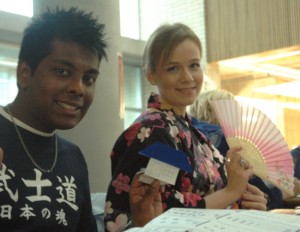
Jassneal Dass and Nina Ramsay demonstrated origami at the Japan table for International Education Week. (Photo by Sarah Casimong)
Dressed in traditional kimonos, members of Nihon Kwantlen Kurabu, otherwise known as Kwantlen’s Japanese Club, participated in International Education Week, with tables dedicated to Japanese calligraphy and origami, on Nov. 18.
Jassneal Dass, the Japanese club’s intercampus liaison, joined Nina Ramsay and other Japanese club students in creating origami.
“Personally, I’ve always had interest for [Japanese culture],” Dass said. “It started with video games first. Then anime on TV. Then I started learning more about the culture and it just became more interesting.
“I always wanted to learn the language because we didn’t have Japanese in high school. I was in French immersion so I was forced to learn French and I hated it. “
“[My Japanese] is pretty good,” Dass said. “I think I speak Japanese better than I speak Hindi, which is a good thing. I’ve been studying for three years. Some of my friends have been studying for seven years. They’re so much better than me.”
Dass admitted that Japanese calligraphy was challenging at first, but after writing out the characters hundreds of times, he has mastered the art.
He still, however, has yet to ace origami. The traditional Japanese art of paper folding is a traditional art form that dates back to the 17th century, according to House of Japan.
“I’m pretty terrible with art, so I’m not that great,” Dass admitted. “This is one of the first times I’m doing it. I’ve done it a few times in high school and elementary but I can’t even fold the paper correctly. I still need more practice on this.”
“I’ve always been interested in Japanese culture and when I got into university I was like, ‘Oh, there’s a Japanese class. Heck yes, I’m there,’” said Breena Kaye, who demonstrated calligraphy at the Japan table. “It’s actually a lot of fun.”
She encourages people who are interested in Japanese culture to take a Japanese language class at Kwantlen.
“You live and breathe Japanese for a semester,” Kaye said. “You get to learn something different instead of sitting in a classroom getting to learn people talk for an hour and a half. You get to really interact with your teacher, you get to interact with each other and it’s a really good way to learn.”
The Japanese Club meets at both the Surrey and Richmond campuses. It delves into Japanese culture, anime and manga, as well as Japanese history and cuisine.
Meeting are held in Richmond on Tuesdays at 1 p.m. in room 1815 and in Surrey on Thursdays at 1 p.m. in room D326, Fir building.
For more information, visit the Japanese club’s Facebook page.
Kwantlen’s aboriginal club ready for action
November 14, 2010 by Sarah Casimong · Leave a Comment
Kwantlen’s aboriginal group may have just been made offical on Friday, but it already has great plans.
“We generally just have a lot of fun and get to know each other,” said Melinda Bige, main contact person for the Aboriginal Students Club. “Right now we are just in the bare beginnings…we’re just trying to organize events around what the students want to do.”
Members of the club, which meets Wednesdays at 4:30 p.m. at Kwantlen’s Aboriginal Gathering Place, have already come up with ideas for members, including ultimate frisbee and a canoe trip.
“They want to do fundraising for a canoe trip. That’s traditional to the Semiahmoo tribe and very spiritual,” said Bige, adding that they hope to do it in the summer.
In addition to recreational activities, the club also has big plans to get involved politically.
“The more political [students], like myself, want to do conferences on indigenous rights and stuff around the world. Right now, we just participated in a campaign for GIA, which is Global Indigenous Youth for Action. It’s part of the United Nations. We just took some pictures with some signs that support the group,” she said.
The priority for the club is also to provide education on aboriginal culture and issues.
“We have a lot of urban aboriginal students, so they’re just relearning their own culture, like myself,” said Bige. “We talk about aboriginal issues, too. I’m planning on showing Kevin Annett’s documentary on repentance.”
Although the club’s focus is on aboriginal culture and identity, Bige said membership is not limited to aboriginals, and encourages people of all ethnicities to drop by.
“It’s also not culturally exclusive, so everyone can be involved. You don’t have to be aboriginal.”
On Nov. 17, the club will meet at 4 p.m. at the Grassroots Cafe instead of the gathering room. For more information, contact Melinda Bige at melinda_bige@hotmail.com.
Students turn out for speed dating at Kwantlen
November 1, 2010 by Sarah Casimong · Leave a Comment
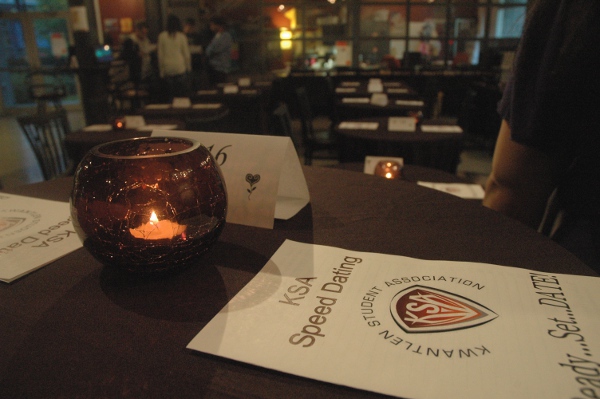
Speed dating took place at the Grassroots Cafe at the Surrey campus on Oct. 21. (Photo by Sarah Casimong)
With a busy school schedule, who has time to meet a potential boyfriend or girlfriend? Speed dating might be the easiest and fastest way for students to get a date.
The KSA’s speed dating event took place on Oct. 21 at the Grassroots Cafe at the Surrey campus. Female and male students went out to participate, to meet new people and maybe even get a date. It turned out to be so popular that the Kwantlen Student Association had to put a few names on a waiting list for future events.
“There’ll be another one [next semester],” said Reena Bali, director of events. “We might do two because the demand for this one is pretty high, like a waiting list.”
However, some KSA members had to fill in for the registrants who got cold feet and never showed up.
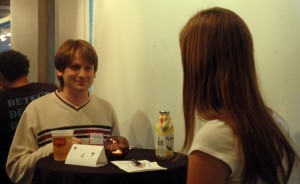
Nathan Griffiths takes part in speed dating at Kwantlen's Grassroots Cafe on Oct. 21. Each table was occupied by a couple who had five minutes to talk before the men moved to the next table. (Photo by Sarah Casimong)
“There was supposed to be 20 [participants]. Twenty guys, 20 girls, but only half showed up. We’re thinking for next year to maybe do a $5 deposit. There were a lot of people on the waiting list that wanted to [come] but we weren’t able to tell them because we thought everyone was going to show up,” Bali said.
The event started with an ice-breaker activity before participants took to the tables to start off five-minute conversations. After five minutes were up, the men would move to meet another woman at the next table.

The speed dating event started at 4 p.m. at the Grassroots Cafe. Participants signed in to get their assigned numbers and name tags before playing an ice breaker. (Photo by Sarah Casimong)
Before the event started, some students opened up right before their first experience with speed dating.
“I don’t think [I'm nervous]; I’ll find out,” said Imtiaz Khan, an accounting student, before the event. “I just want to try it out. I’ve never tried this speed dating, so yeah, [this is] just for fun.”
Manpreet Uppal, a third-year nursing student, was also excited and nervous.
“This is just for fun, to do something different. I’ve never done it before. I wanted to do it last year, but I think it didn’t go with my school schedule and today it did. I am nervous now,” she said.
The next speed dating event is scheduled for Feb. 10, 2011. For more information, visit the KSA website.
RELATED: A personal take on the speed-dating experience.
Get Involved Week 2010: 63.8 per cent increase in participants
October 3, 2010 by Sarah Casimong · Leave a Comment
Although student life and development fell short of its goal for 300 participants for this year’s Get Involved Week, there has been a 63.8 per cent increase over last year in the number of people involved.
Kwantlen’s annual community-building charity event, which took place Sept. 20-25, had a total of 131 people involved in 32 different activities. Each participant was required to donate a minimum of $10 for Free The Children.
According to Kurt Penner, student life and development coordinator, that is an improvement from the 80 participants last year, 20 employees and 60 students.
Of this year’s 131 participants, 95 were students, 21 were employees, 13 were community members and two were alumni. That is a 58.3 per cent increase in student participation from last year. The Surrey campus had 81 participants, 61.8 per cent of all who got involved, while Langley had the fewest number of participants: two.
The final donation total came to $1,241, $491 more than what was made in 2009.
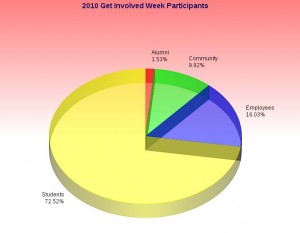
Security officers on campus put students at ease
September 27, 2010 by Sarah Casimong · Leave a Comment

In case of emergency, speaker phones are located on the Surrey, Richmond and Langley campuses. The two-way speaker phone is answered by security personnel and faculties. (Photo by Sarah Casimong)
Most students, occupied by the stress of classes, barely have time to think about the safety of their environment at the school. It might take a rare incident before students look into what is provided for them by faculties and what they should do if a threat should occur.
Of those asked whether they feel safe at Kwantlen, most students said yes. Many acknowledged the presence of security officers as the main reason for their ease.
According to the school website, there are security officers on all four campuses. With the exception of Cloverdale, all campuses have emergency speaker phones students can use to call security personnel.
Jayson Bulahan, 19, who is studying criminology at the Surrey and Richmond campuses, has been attending Kwantlen for two years and feels free from harm.
“I’m aware that there are security guards [around] the campus area,” said Bulahan. “So far, there hasn’t been any issues within campus that has ever made me feel unsafe.”
Chiny Babilonia, 21, taking criminology, had similiar views. “I do feel somewhat safe at night,” said Babilonia. “I used to take night classes at the Surrey campus and after class I don’t feel any danger or harm. Whenever I would walk in the parking lot to go to my car, [knowing that there are] security guards walking around campus when it’s near closing time, [helps me feel] safe.”
Some students credited the school’s size as a safety factor.
“I feel at ease at school, whether it be night or day,” said Michael Viloria, 20, taking history at both Surrey and Richmond. “I think the school is easy-going, although, the threats may come from the outside. Even so, the school isn’t as big as other universities, so finding help in the security office doesn’t require much effort.”
However, not all students feel safe. Michelle Mariano, 27, a psychiatric nursing student, is afraid to walk alone at night.
“I don’t see any security around,” said Mariano. “Last semester I had a late class. It’s scary if I have to walk by myself.”
For more information on security, visit the security section of the school site.

